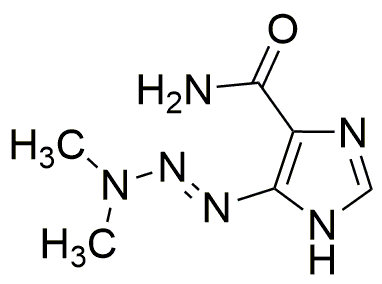Dacarbazine is widely utilized in research focused on
- Cancer Treatment: Primarily used as a chemotherapy agent for treating melanoma and Hodgkin's lymphoma, offering a vital option for patients with these conditions.
- Clinical Trials: Frequently involved in clinical studies to assess its efficacy in combination therapies, helping to advance cancer treatment protocols.
- Pharmaceutical Development: Serves as a reference compound in drug formulation research, aiding in the development of new anticancer drugs.
- Biochemical Research: Utilized in laboratory settings to study cellular responses to chemotherapy, providing insights into cancer cell behavior and resistance mechanisms.
- Veterinary Medicine: Occasionally explored for use in treating certain cancers in animals, expanding its application beyond human medicine.
Información general
Propiedades
Seguridad y normativas
Aplicaciones
Dacarbazine is widely utilized in research focused on
- Cancer Treatment: Primarily used as a chemotherapy agent for treating melanoma and Hodgkin's lymphoma, offering a vital option for patients with these conditions.
- Clinical Trials: Frequently involved in clinical studies to assess its efficacy in combination therapies, helping to advance cancer treatment protocols.
- Pharmaceutical Development: Serves as a reference compound in drug formulation research, aiding in the development of new anticancer drugs.
- Biochemical Research: Utilized in laboratory settings to study cellular responses to chemotherapy, providing insights into cancer cell behavior and resistance mechanisms.
- Veterinary Medicine: Occasionally explored for use in treating certain cancers in animals, expanding its application beyond human medicine.
Documentos
Hojas de datos de seguridad (HDS)
La SDS proporciona información de seguridad completa sobre la manipulación, el almacenamiento y la eliminación del producto.
Especificación del producto (PS)
La PS proporciona un desglose completo de las propiedades del producto, incluida la composición química, el estado físico, la pureza y los requisitos de almacenamiento. También detalla los rangos de calidad aceptables y las aplicaciones previstas del producto.
Certificados de análisis (COA)
Busque certificados de análisis (COA) ingresando el número de lote del producto. Los números de lote y de partida se pueden encontrar en la etiqueta de un producto después de las palabras "Lote" o "Lote".
Número de catálogo
Número de lote/lote
Certificados de origen (COO)
Este certificado de origen confirma el país en el que se fabricó el producto y también detalla los materiales y componentes utilizados en él y si se deriva de fuentes naturales, sintéticas u otras fuentes específicas. Este certificado puede ser necesario para cumplir con las normativas aduaneras, comerciales y regulatorias.
Número de catálogo
Número de lote/lote
Hojas de datos de seguridad (HDS)
La SDS proporciona información de seguridad completa sobre la manipulación, el almacenamiento y la eliminación del producto.
DownloadEspecificación del producto (PS)
La PS proporciona un desglose completo de las propiedades del producto, incluida la composición química, el estado físico, la pureza y los requisitos de almacenamiento. También detalla los rangos de calidad aceptables y las aplicaciones previstas del producto.
DownloadCertificados de análisis (COA)
Busque certificados de análisis (COA) ingresando el número de lote del producto. Los números de lote y de partida se pueden encontrar en la etiqueta de un producto después de las palabras "Lote" o "Lote".
Número de catálogo
Número de lote/lote
Certificados de origen (COO)
Este certificado de origen confirma el país en el que se fabricó el producto y también detalla los materiales y componentes utilizados en él y si se deriva de fuentes naturales, sintéticas u otras fuentes específicas. Este certificado puede ser necesario para cumplir con las normativas aduaneras, comerciales y regulatorias.


